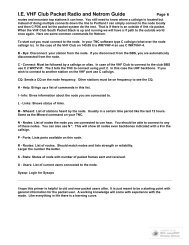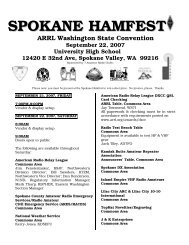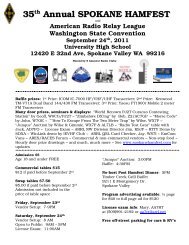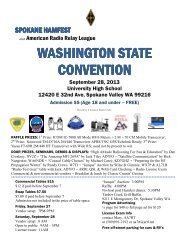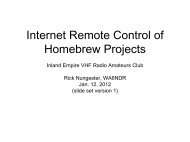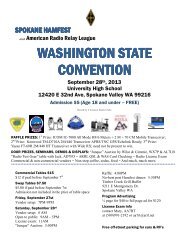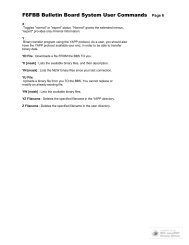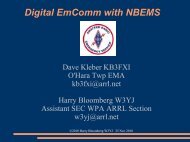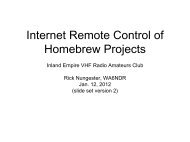VSWR and Antenna Tuners
VSWR and Antenna Tuners
VSWR and Antenna Tuners
You also want an ePaper? Increase the reach of your titles
YUMPU automatically turns print PDFs into web optimized ePapers that Google loves.
<strong>VSWR</strong> <strong>and</strong> <strong>Antenna</strong> <strong>Tuners</strong><br />
RF Mismatch<br />
<strong>VSWR</strong><br />
Return Loss<br />
Reflection Coefficient<br />
<strong>Antenna</strong> <strong>Tuners</strong><br />
Manual<br />
Automatic<br />
By Jack Tiley AD7FO<br />
1
<strong>VSWR</strong> <strong>and</strong> <strong>Antenna</strong> <strong>Tuners</strong><br />
• In coaxial or open-wire line, current flowing in each of the two<br />
conductors travel in opposite directions.<br />
• If the physical spacing between the two parallel conductors in an<br />
open-wire line is small in terms of wavelength, the phase difference<br />
between the currents will be very close to 180°.<br />
• If the two currents also have equal amplitudes, the field generated<br />
by each conductor will cancel that generated by the other, <strong>and</strong> the<br />
line will not radiate energy, even if it is many wavelengths long.<br />
2
What is a Transmission line?<br />
Equivalent of an infinitely long lossless transmission line using lumped circuit constants.<br />
A transmission line can be thought of as an infinite number of small<br />
series inductors on each leg of the transmission line with small<br />
capacitors coupling between the them. This model applies to all<br />
transmission lines whether open wire, ladder line, twin lead or coax.<br />
The characteristic impedance of the line is determined by the conductor<br />
diameters <strong>and</strong> the separation between them for open wire <strong>and</strong> twin lead<br />
transmission line <strong>and</strong> by the ratio of the center conductor diameter to the<br />
inside diameter of the shield surrounding the center conductor in coaxial<br />
cable.<br />
3
Importance of <strong>VSWR</strong><br />
• It is important that your transmitter operates into<br />
a matching impedance to prevent damage<br />
• A common misconception is that your <strong>VSWR</strong><br />
must be 1:1. A 1:1 <strong>VSWR</strong> implies a perfect<br />
match between the transmitter <strong>and</strong> the antenna<br />
system.<br />
• It is possible to have a low <strong>VSWR</strong> <strong>and</strong> an<br />
antenna system that is a poor radiator.<br />
• A dummy load may have a 1:1 match but it<br />
will not radiate your signal.<br />
4
Many Ways To Express An<br />
Impedance Mismatch<br />
The concept of <strong>VSWR</strong> is easy to grasp <strong>and</strong> its<br />
importance in an antenna system does not require an<br />
engineering degree to underst<strong>and</strong>.<br />
<strong>VSWR</strong> (Voltage St<strong>and</strong>ing Wave Ratio)<br />
Reflection Coefficient<br />
Mismatch Loss<br />
Return Loss<br />
5
<strong>VSWR</strong><br />
Example calculation<br />
For a transmission line with a max voltage of 10 volts<br />
<strong>and</strong> a minimum voltage of 5 volts:<br />
Emax 10<br />
<strong>VSWR</strong>= = = 2.0<br />
Emin 5<br />
<strong>VSWR</strong> is normally shown as the ratio to one or in this<br />
case the <strong>VSWR</strong> would be stated as 2.0 : 1<br />
6
Reflection coefficient<br />
Example calculation<br />
Reflection coefficient (ρ)<br />
Is the ratio between the two impedances<br />
ρ = (Z – Zo) / (Z + Zo)<br />
For an antenna of 100 Š <strong>and</strong> a transmitter with a 50 Š<br />
output with no reactive (imaginary) component<br />
ρ = (100 – 50) / (100 + 50) or ρ =50/150 or ρ = .333<br />
7
<strong>VSWR</strong> Using Reflection<br />
coefficient Example<br />
For an antenna of 100 Š <strong>and</strong> a transmitter with a 50 Š<br />
output (with no reactive or imaginary component)<br />
<strong>VSWR</strong>= (1+ p)/ (1- p)<br />
<strong>VSWR</strong>= (1+.333) / (1-.333) or <strong>VSWR</strong>= 1.333/.667 or<br />
<strong>VSWR</strong>= 2.00<br />
<strong>VSWR</strong> is normally shown as the ratio to one or in this case<br />
the <strong>VSWR</strong> would be stated as 2.0 : 1<br />
8
Return Loss Example<br />
Return Loss<br />
Return Loss (RL) is the ratio of the forward power to the reflected<br />
power in dB. A perfect load would have infinite return loss meaning<br />
that no power would be returned to the source (transmitter). A short<br />
or open would have zero dB return loss meaning that there is zero<br />
db loss in the reflected signal relative to the forward signal meaning<br />
it was totally reflected back to the source (transmitter).<br />
RL= -10 (log10 (ρ²))<br />
For an antenna of 100 Š <strong>and</strong> a transmitter with a 50 Š output (with<br />
no reactive or imaginary component)<br />
RL=-10 (log10 (.333²))<br />
RL = -10 (log10 (.1109))<br />
RL = -9.55dB<br />
9
Mismatch Error Loss<br />
Example<br />
For an antenna with a reflection coefficient of .333<br />
(or a <strong>VSWR</strong> of 2.0 : 1)<br />
Mismatch Loss = -10 (log (1- ρ²))<br />
Mismatch Loss = -10 (log (1- (.333)²))<br />
Mismatch Loss = -10 (log (1- .1109))<br />
Mismatch Loss = -10 (log (.8891))<br />
Mismatch Return Loss = -10 (-.0510)<br />
Mismatch Return Loss = .510 dB<br />
10
Comparison of Methods<br />
To Express Mismatch<br />
11
The Ideal Situation<br />
• Except for h<strong>and</strong>ie-talkies, most antennas are not<br />
connected directly to a transmitter. The antenna is<br />
usually located some distance from the transmitter <strong>and</strong><br />
requires a feedline to transfer power from the<br />
transmitter to the antenna.<br />
Transmitter Coaxial line <strong>Antenna</strong><br />
50Š 50Š 50Š<br />
12
The Real World<br />
• In order to transfer maximum power into a load (<strong>Antenna</strong><br />
<strong>and</strong> Transmission line) impedance must match the<br />
generator (transmitter) impedance. Any difference, or<br />
mismatching, of these impedances would result in less than<br />
maximum power transfer to the antenna.<br />
• In the case where the <strong>VSWR</strong> is 1:1 <strong>and</strong> the voltage <strong>and</strong><br />
current will be constant over the whole length of the<br />
feedline. Any deviation from this situation will cause a<br />
"st<strong>and</strong>ing wave" of voltage <strong>and</strong> current to exist on the<br />
transmission line.<br />
13
What Causes St<strong>and</strong>ing<br />
Waves<br />
As the Forward <strong>and</strong> Reverse waves travel in opposite<br />
directions, they set up an interference pattern called a<br />
"st<strong>and</strong>ing wave". At certain places on the feedline the<br />
voltages will add producing a voltage maximum, <strong>and</strong> at<br />
others their relative phase difference will cause a voltage<br />
minimum to exist on the feedline. These maximum <strong>and</strong><br />
minimum points occur exactly ¼ wavelength apart.<br />
¼ λ<br />
Transmitter<br />
St<strong>and</strong>ing wave<br />
Mismatched<br />
antenna<br />
14
What Causes St<strong>and</strong>ing<br />
Waves<br />
• Measuring these st<strong>and</strong>ing waves in coaxial cable presents a<br />
problem since the "inside" of the cable is not readily<br />
available for measurements.<br />
¼ λ<br />
St<strong>and</strong>ing wave<br />
• Consequently, <strong>VSWR</strong> measurements on coax are usually<br />
made at the transmitter end of the feedline. Therefore you<br />
are presented with the <strong>VSWR</strong> of the entire system which<br />
includes all losses associated with the entire system.<br />
15
The Open or Shorted Line<br />
• We want the waves on the transmission line (both<br />
voltage <strong>and</strong> current) to travel one way <strong>and</strong> deliver their<br />
energy to the desired load, which in this case may be an<br />
antenna where it is to be radiated. If all the energy gets<br />
reflected (for example, by an open or short circuit) at the<br />
end of the line, then none gets absorbed, producing a<br />
perfect "st<strong>and</strong>ing wave" on the line.<br />
Transmitter Coaxial line Open or<br />
Short<br />
• This is a bad, undesired situation. In fact, when the<br />
power meant to be radiated comes back into the<br />
transmitter at full strength, it will usually burn out the<br />
electronics there. Modern transceivers will reduce their<br />
output power if you try to operate into a high <strong>VSWR</strong> load.<br />
16
Long Feedlines Mask<br />
The load <strong>VSWR</strong><br />
If we have a long run of lossey transmission line the<br />
load/antenna <strong>VSWR</strong> can look better than it actually is.<br />
Using return loss we can see that the signal going to the<br />
load is attenuated by 4 dB <strong>and</strong> the signal returning from<br />
the mismatched load is attenuated an additional 4 dB for<br />
a total return loss of 8 dB.<br />
Transmitter Coaxial line Open or<br />
Short<br />
4dB of loss<br />
Eight dB of return loss is equal to a 2.33:1 <strong>VSWR</strong>. This<br />
is with an open or short (no antenna connected). This is<br />
the reason when you are testing an antenna <strong>VSWR</strong> it is<br />
important to measure it with a short low loss cable or<br />
with your <strong>VSWR</strong> meter directly at the antenna.<br />
17
St<strong>and</strong>ing Waves<br />
It doesn't take an open or short circuit to cause a<br />
reflected wave. All it takes is a mismatch in impedance<br />
between the Transmission line <strong>and</strong> the load.<br />
Transmitter<br />
Mismatched<br />
antenna<br />
If the reflected wave is not as strong as the forward wave,<br />
then a st<strong>and</strong>ing wave pattern will be observed, but the<br />
nulls will not be as deep nor the peaks as high as when<br />
an open or short is at the end of the transmission line.<br />
18
It Is Not That Simple<br />
• The actual impedance of any device is a complex number<br />
that has a reactive component associated with it.<br />
Z0 = Resistance + j Reactance or Z0 = R+j<br />
Impedance<br />
θ<br />
Reactance<br />
Resistance<br />
• The phase (θ) of the impedance will be advanced or<br />
delayed depending upon whether the antenna appears<br />
inductive or capacitive to the feedline.<br />
• In the real world <strong>VSWR</strong> calculations require including the<br />
imaginary value in our calculations.<br />
19
The Smith Chart<br />
Complex impedance can bs shown on a smith chart so<br />
that the effects of changes in phase (cable length) can<br />
be easily seen<br />
Reactance<br />
Constant <strong>VSWR</strong><br />
Nominal<br />
Resistance (50Ω)<br />
20
The Full Reflection<br />
Coefficient Equation<br />
• This is the equation that takes into account the reactive<br />
component of each of the impedances.<br />
ρ =<br />
(Z1+ j1) - (Z2+ j2)<br />
(Z1+ j1) + (Z2+ j2)<br />
• Similar substations would be made to the previously<br />
shown calculations to take into account the reactive<br />
component.<br />
21
Measuring <strong>VSWR</strong><br />
<strong>VSWR</strong> can be measured by a number of methods. You can<br />
measure the <strong>VSWR</strong> statically (without transmitting) using one of the<br />
following methods:<br />
• MFJ 259 or 269 <strong>Antenna</strong> analyzers<br />
• <strong>Antenna</strong> Noise Bridge from Palomar,<br />
MFJ, or from plans in the ARRL H<strong>and</strong>book<br />
• Spectrum analyzer with a tracking generator<br />
<strong>and</strong> an external directional coupler or RF bridge<br />
22
Measuring <strong>VSWR</strong><br />
Directional Couplers<br />
RF Bridges<br />
23
Measuring <strong>VSWR</strong><br />
<strong>VSWR</strong> can be measured using a <strong>VSWR</strong> meter or directional watt<br />
meter. measure the<br />
• SWR/Power meter<br />
• Directional Wattmeter's<br />
• Many antenna tuners have built in directional<br />
wattmeter/<strong>VSWR</strong> meters<br />
24
Measuring <strong>VSWR</strong><br />
• For UHF <strong>and</strong> Microwave frequencies a Slotted Line <strong>and</strong><br />
<strong>VSWR</strong> Indicator can be used<br />
25
Matching The Transmitter<br />
To The <strong>Antenna</strong><br />
• Manual <strong>and</strong> automated antenna tuners<br />
• Balun’s <strong>and</strong> matching transformers<br />
26
Matching The Transmitter<br />
To The <strong>Antenna</strong><br />
• You can use a balun or transformer to match a 50 Ω transmitter to a<br />
higher impedance antenna or transmission line<br />
• A balun or transformer can also be used to connect unbalanced<br />
transmitter outputs to balanced transmission line<br />
27
<strong>Antenna</strong> <strong>Tuners</strong><br />
• An antenna tuner, transmatch , doesn't really TUNE<br />
your antenna OR ANY PART OF IT!<br />
• What an antenna tuner or transmatch does do, is<br />
transform the impedance at the antenna feed output at<br />
the radio to a value that your transceiver can h<strong>and</strong>le,<br />
(typically 50 Ohms).<br />
• When thinking about antenna tuners <strong>and</strong> SWR, it's<br />
important to remember that the tuner has no effect<br />
whatsoever on the SWR between itself <strong>and</strong> the antenna.<br />
It is the SWR between the transmitter <strong>and</strong> the tuner<br />
that is changed with the tuner controls.<br />
28
<strong>Antenna</strong> <strong>Tuners</strong><br />
In layman's terms, all a tuner does is act as a<br />
kind of adjustable impedance transformer<br />
between the radio <strong>and</strong> the antenna. It takes<br />
whatever impedance the antenna system<br />
presents, up to the design limits of the tuner, <strong>and</strong><br />
attempts to convert it back to 50 Ohms--or<br />
something reasonably close to that value for the<br />
transceiver. The transceiver will see a 50 Ohm<br />
impedance, <strong>and</strong> deliver it's maximum designed<br />
RF output.<br />
29
Remote <strong>Antenna</strong> <strong>Tuners</strong><br />
If the output of the tuner does not see 50 Ω if there is a<br />
mismatch is at the antenna there will be <strong>VSWR</strong> currents<br />
along the transmission line in-between the tuner <strong>and</strong> the<br />
antenna that will produce additional signal loss.<br />
The ideal point for an antenna tuner is at the antenna<br />
end of the feed line just before the antenna itself.<br />
30
What Is Inside An<br />
<strong>Antenna</strong> Tuner?<br />
Variable inductors <strong>and</strong> capacitors<br />
L Configuration<br />
T Configuration<br />
pi Configuration<br />
Series Configuration<br />
31
How does an <strong>Antenna</strong><br />
Tuner work?<br />
<strong>Antenna</strong> <strong>Tuners</strong> are based upon lumped components<br />
as shown in the previous slide.<br />
The website listed below has a detailed explanation of<br />
how an antenna tuner actually matches one complex<br />
impedance to another, including the equations for<br />
solving the components needed to accomplish the<br />
match.<br />
http://en.wikipedia.org/wiki/<strong>Antenna</strong>_tuner<br />
32
What Is Inside A<br />
Manual <strong>Antenna</strong> Tuner?<br />
33
NOW LET'S LEARN TO<br />
Use the <strong>Antenna</strong> TUNER<br />
Most antenna tuners have an inductance rotary switch<br />
<strong>and</strong> two capacitors. (refer to photo) The capacitors are<br />
often labeled ANTENNA <strong>and</strong> TRANSMITTER. In some<br />
antenna tuners the inductance switch is replaced with a<br />
continuously variable inductance, known as a roller<br />
inductor.<br />
SHOCK HAZARD! NEVER TRANSMIT<br />
WITH THE TUNER COVER OFF!<br />
34
NOW LET'S LEARN TO<br />
Use the <strong>Antenna</strong> TUNER<br />
Place both capacitor controls at their mid-range<br />
positions. Don't trust the knob markers if this is your first<br />
experience with the tuner! If you are comfortable with<br />
the next procedure, remove the cover of the tuner <strong>and</strong><br />
turn the knobs until the moving capacitor plates are only<br />
half meshed with the stationary plates. If the knobs are<br />
pointing to half scale with the reference markings on the<br />
knobs <strong>and</strong> front cover you are okay. If not, loosen their<br />
Allen screws <strong>and</strong> rotate the knobs so that they point to<br />
mid scale. Re-tighten the knobs, replace the tuner cover<br />
<strong>and</strong> you're ready to go.<br />
35
Best Practice caution<br />
• Play it safe <strong>and</strong> un-key before turning the inductor<br />
switch...un-key first....turn the switch...key up....repeat as<br />
needed until lowest SWR <strong>and</strong> maximum output. Be gentle<br />
to your radio; keep the key-down periods as short as<br />
possible. Depending on the impedance at the antenna<br />
input (<strong>and</strong> the overall design of the tuner) you may not be<br />
able to obtain a flat 1:1 SWR on all frequencies <strong>and</strong><br />
b<strong>and</strong>s. Any thing below a 2:1 or lower will work well.<br />
• Also important to remember is that your SWR will change,<br />
go up, as you tune further away from the frequency you<br />
used to "trick" your radio! So re-check <strong>and</strong> re-tune as<br />
needed as you move around the b<strong>and</strong>.<br />
36
Using the <strong>Antenna</strong> Tuner<br />
Tuning Procedure:<br />
1. Position the TRANSMITTER<br />
control to mid scale.<br />
2. Position the ANTENNA control to 0 on the<br />
corresponding scale.<br />
3. Place the BYPASS/TUNE switch in the TUNE position.<br />
4. Apply just enough power to obtain noticeable deflection<br />
on the reflected power meter or SWR meter (5-10<br />
watts).<br />
5. Adjust the INDUCTOR control for lowest deflection on<br />
the reflected power.<br />
WARNING: Never transmit while changing the<br />
INDUCTOR switch.<br />
37
Using the <strong>Antenna</strong> Tuner<br />
6. Carefully adjust the TRANSMITTER control for the<br />
lowest reflected power, then increase the ANTENNA<br />
control slightly <strong>and</strong> adjust the TRANSMITTER control for<br />
the lowest reflected power. Again, increase the<br />
ANTENNA control slightly <strong>and</strong> adjust the<br />
TRANSMITTER control for lowest reflected power.<br />
Repeat this process for lowest reflected power.<br />
Note: These controls interact. Go back <strong>and</strong> forth<br />
between these adjustments as many times as<br />
required until the lowest reflected power (best SWR)<br />
is obtained.<br />
38
Using the <strong>Antenna</strong> Tuner<br />
7. After the lowest reflected power (or SWR) is obtained in<br />
step 6, use the INDUCTOR switch to reduce the<br />
inductance one switch position (L is the lowest<br />
inductance setting <strong>and</strong> A is the highest inductance<br />
setting). Adjust the TRANSMITTER <strong>and</strong> ANTENNA<br />
controls for the lowest SWR. (A is the highest<br />
inductance setting). Tune for lowest SWR.<br />
Note: Always use as little inductance as possible.<br />
8. After a low SWR is obtained, the transmitter power may<br />
be increased to the maximum allowable for your <strong>Antenna</strong><br />
Tuner<br />
9. Note the antenna tuner settings so you can return to<br />
them the next time you operate on that frequency.<br />
39
The Cross Needle<br />
Power/<strong>VSWR</strong> Meter<br />
• The cross needle power meter simultaneously shows forward <strong>and</strong><br />
reflected power. Where the two needled cross there is an additional<br />
scale that shows the SWR<br />
40
What is inside an Automatic<br />
<strong>Antenna</strong> Tuner?<br />
Firmware<br />
Directional Coupler<br />
Microprocessor<br />
Relays<br />
Capacitors<br />
Inductors<br />
41
Automatic <strong>Tuners</strong><br />
Now that you have seen what it takes to set up a manual<br />
antenna tuner you will appreciate the automatic antenna<br />
tuner. An automatic antenna tuner automatically goes<br />
through the same process you would do with a manual<br />
antenna tuner. A microprocessor monitors the antenna<br />
<strong>VSWR</strong> <strong>and</strong> uses relays to switch in inductance <strong>and</strong><br />
capacitance until a satisfactory <strong>VSWR</strong> is obtained.<br />
Typically less than 5 seconds<br />
Many of today's automatic antenna tuners will store the<br />
frequency <strong>and</strong> settings so when you come back to that<br />
frequency the tuner can quickly go back to the previous<br />
settings making tune up very fast (1-2 seconds)<br />
42
Properly Connecting An<br />
<strong>Antenna</strong> Tuner<br />
Optional<br />
43
The <strong>VSWR</strong> Meter<br />
Whether part of you antenna tuner or a separate<br />
instrument a <strong>VSWR</strong> Meter consists of a directional<br />
coupler that samples forward <strong>and</strong> reflected voltage, a<br />
detector diode <strong>and</strong> apply the detected voltage to<br />
metering circuit. The metering circuit can have a switch<br />
to select forward <strong>and</strong> reflected power or dual meters.<br />
44
Any Questions?<br />
<strong>Antenna</strong> tuner reference sites<br />
http://www.hamuniverse.com/tuner.html<br />
http://www.hamuniverse.com/wc7iswr.html<br />
45
Conversion Chart<br />
46



